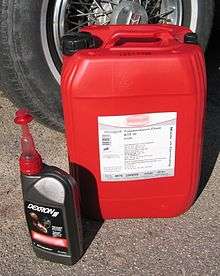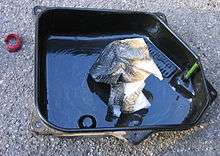Automatic transmission fluid

Automatic transmission fluid (ATF), also known as transmission fluid or tranny fluid for short, is the fluid used in vehicles with self-shifting or automatic transmissions. It is typically coloured red or green to distinguish it from motor oil and other fluids in the vehicle.
The fluid is optimized for the special requirements of a transmission, such as valve operation, brake band friction and the torque converter, as well as gear lubrication.
ATF is also used as a hydraulic fluid in some power-assisted steering systems, as a lubricant in some 4WD transfer cases, and in some modern manual transmissions.
Modern use
Modern ATF typically contains a wide variety of chemical compounds intended to provide the required properties of a particular ATF specification. Most ATFs contain some combination of additives that improve lubricating qualities,[1][2][3] such as anti-wear additives, rust and corrosion inhibitors, detergents, dispersants and surfactants (which protect and clean metal surfaces); kinematic viscosity and viscosity index improvers and modifiers, seal swell additives and agents (which extend the rotational speed range and temperature range of the additives' application); anti-foam additives and anti-oxidation compounds to inhibit oxidation and "boil-off"[4] (which extends the life of the additives' application); cold-flow improvers, high-temperature thickeners, gasket conditioners, pour point depressant and petroleum dye. All ATFs contain friction modifiers, except for those ATFs specified for some Ford transmissions and the John Deere J-21A specification;[5] the Ford ESP (or ESW) - M2C-33 F specification Type F ATF (Ford-O-Matic) and Ford ESP (or ESW) - M2C-33 G specification Type G ATF (1980s Ford Europe and Japan)[2] specifically excludes the addition of friction modifiers.[2] According to the same oil distributor, the M2C-33 G specification requires fluids which provide improved shear resistance and oxidation protection, better low-temperature fluidity, better EP (extreme pressure) properties and additional seal tests over and above M2C-33 F quality fluids.
There are many specifications for ATF, such as the DEXRON and MERCON series, and the vehicle manufacturer will identify the ATF specification appropriate for each vehicle. The vehicle's owner's manual will typically list the ATF specification(s) that are recommended by the manufacturer.
Automatic transmission fluids have many performance-enhancing chemicals added to the fluid to meet the demands of each transmission. Some ATF specifications are open to competing brands, such as the common DEXRON specification, where different manufacturers use different chemicals to meet the same performance specification. These products are sold under license from the OEM responsible for establishing the specification. Some vehicle manufacturers will require "genuine" or Original Equipment Manufacturer (OEM) ATF. Most ATF formulations are open 3rd party licensing, and certification by the automobile manufacturer.
Each manufacturer has specific ATF requirements. Incorrect transmission fluid may result in transmission malfunction or severe damage.
Current fluids
- ATF+4 - Most Dodge, Jeep, Chrysler, and Plymouth replaces ATF+3, ATF+2, ATF+[6]
- DEXRON III/Mercon - Most pre-2006 GM and Ford, Mercury, Lincoln, pre-2004 Toyota products, many Asian vehicles, some Asian power steering fluid applications, some Ford/Mazda manual transmissions. It is generally less expensive than Dexron VI/Mercon V.
- DEXRON VI - Most after 2006 GM, some Ford applications, replaces Dexron III in GM products.
- Mercon V - Most Ford, Mercury, Lincoln, Mazda B-Series, 2001-08 Mazda Tribute, Tribute Hybrid.
- Mercon LV - Some Ford(DuratecHE), 2009-11 Mazda Tribute, Mazda in Europe or Asia.[7]
- Mercon SP - For the Ford 6R transmission
- Toyota ATF Type T-IV (T4) - Some Toyota, Lexus including "Gen 1" hybrid CVT), some Mazda. Replaces Type T, Type T-II and Type T-III.
- Toyota ATF WS - Most new models introduced with model year 2004 Toyota and Lexus including "Gen 2" and later hybrid CVT (except non-hybrid CVT); Volvo. It is not applicable in applications requiring ATF Type T-IV.
- DW-1 - All Honda and Acura (except CVT), replaces Z1 specification fluid
- Diamond SP-III (or SP3) - All Mitsubishi (including CVT's), Hyundai and Kia 4-speed automatic transmission.
- Diamond SP-IV (or SP4) - All Hyundai and Kia 6-speed automatic transmission.
- Nissan Matic fluids - For Nissan and Infiniti vehicles:
- Matic D is for 3- and 4-speed transmissions,
- Matic K is for 6-speed front-wheel-drive transmissions,
- Matic J is for 5-speed rear-wheel-drive transmissions,
- Matic-S fluid supersedes Matic-J fluid.
- ATF-HP - For 2005 and later Subaru vehicles, except CVT transmissions. 2004 and earlier Subaru vehicles use Dexron III.
- Mazda M5 (MV) fluid - For the Mazda FN4A-EL/Ford 4F27E and Mazda FS5A-EL/Ford FNR5. Also sold as Ford FNR5 fluid. Genuine Mazda M5 is made by Idemitsu Corporation, available as Idemitsu Type-M. This fluid is NOT Mercon V.
- Mazda FZ fluid - For the SKYACTIV-Drive. Color of this fluid is blue.
Synthetic ATF is available in aftermarket brands, offering better performance and service life for certain applications (such as frequent trailer towing).

The use of a lint-free white rag to wipe the dipstick on automatic transmissions is advised so that the color of the fluid can be checked. Dark brown or black ATF can be an indicator of a transmission problem, vehicle abuse, or fluid that has far exceeded its useful life. Over-used ATF often has reduced lubrication properties and abrasive friction materials (from clutches and brake bands) suspended in it; failure to replace such fluid will accelerate transmission wear and could eventually ruin an otherwise healthy transmission. However, color alone is not a completely reliable indication of the service life of ATF as most ATF products will darken with use. The manufacturer's recommended service interval is a more reliable measure of ATF life. In the absence of service or repair records, fluid color is a common means of gauging ATF service life.
Continuously variable (CVT) and dual-clutch transmissions often use specialized fluids. Transfer cases and differentials in four-wheel-drive/all-wheel-drive vehicles sometimes require specialized fluids, such as Honda Dual Pump-II, Honda VTM-4, Jeep Quadra-Trac, etc.
History
In the 1950s, 1960s, and 1970s, ATF contained whale oil as a friction modifier. But since whale oil would break down at higher temperatures, cars produced in the 1970s and later would not be able to use whale oil because of the higher engine coolant temperatures employed to reduce emissions and save fuel. A moratorium on whale oil at that time prevented the continued production of older ATF such as the original DEXRON formulation (Type B), and the Type A which preceded it. Vintage Chrysler products (Dodge, Plymouth, etc.) used Type A fluid, which is generally difficult to obtain now. It turns out that Type A was basically a nearly 50/50 mix of Type F (Ford) and Dexron (GM), so if you have a pre-1990 Chrysler vehicle, you can mix Type F and Dexron to get a near-match for type A. General Motors began marketing Dexron II Type C and later Dexron II Type D to replace the fluids which were made from whale oil.[8]
Through the late 1970s, Ford transmissions were factory filled with a fluid identified as ESW M2C33-F. To provide a fluid that would be available to the general public for service fill, oil companies and other than factory fill suppliers were allowed to develop fluids meeting the ESW M2C33-F specification and market these fluids under their own brand names but identified as Type F. A second generation of transmission fluid was released in 1974 as the factory fill specification, ESW M2C138-CJ. This fluid was developed to modify the vehicle shifting characteristics and to provide considerable improvement in the oxidation resistance and anti-wear performance. No service fluids were developed and for a short time, DEXRON fluids approved by General Motors were considered acceptable. With continuing changes and improvements in transmission design, a centrifugal lock-up torque converter clutch was introduced into the C5 transmission to smooth engine vibrations sensed by the occupant of the vehicle. An associated shudder problem forced the introduction of the factory fill specification ESP M2C166-H. Servicing transmissions with DEXRON fluids was unacceptable since not all DEXRON fluids were capable of eliminating the shudder phenomenon. The fluids that could be used were a subset of the DEXRON fluids. The advent of Type H as factory fill necessitated the development of a service fluid specification to match the performance expected from Type H. This resulted in the release of the MERCON specification in 1987.[9]
The MERCON specification requires information on the following:
- Colour
- Miscibility with factory fill fluids
- Viscosity at −40 °C, −20 °C, 0 °C and 100 °C
- Flash point
- Copper strip behaviour
- Shift feel with Ford Taurus transmission
- Anti-foaming characteristics
- Elastomer compatibility
- Friction characterization
- Oxidation behaviour at 155 °C
- Transmission cycling
- Vane pump
- Wear tests
One major revision occurred in September 1992, when low-temperature viscosity requirements, volatility requirements, viscosity change limits after high-temperature exposure and improved oxidation limits were introduced. These changes raised the performance of MERCON fluids above ESP M2C166-H levels.
The development of modulating and continuous slipping clutch converters has prompted the need to develop the MERCON V specification. Included are requirements to verify the anti-wear capabilities and anti-shudder characteristics of the fluid.
The Mercon V specification was further modified some time prior to 2007 to make it backward-compatible with Mercon. Ford has / is terminating all license agreements for the manufacture and sale of Mercon in favor of Mercon V.[10]
References
- ↑ "Archived copy". Archived from the original on 2012-04-19. Retrieved 2012-04-18.
- 1 2 3 "BP" (PDF). bp.com.
- ↑ gjjhawk (11 June 2009). "What is Synthetic Oil Made Of?" – via YouTube.
- ↑ "Answers - The Most Trusted Place for Answering Life's Questions". Answers.com.
- ↑ "BP" (PDF). bp.com.
- ↑ "Chrysler LLC ATF+4Ž Info Center". Centerforqa.com. Archived from the original on 2012-03-01. Retrieved 2012-02-28.
- ↑ "Ford Motorcraft Automatic Transmission Fluid Chart" (PDF). Ford Motor Company. Retrieved 2016-10-14.
- ↑ Turbo hydramatic 350 By Ron Sessions, page 20.
- ↑ "A brief history of automatic transmission service fluid" Revised and effective 1 January 1999 Ford Motor.
- ↑ "Archived copy". Archived from the original on 2014-10-06. Retrieved 2012-04-22.